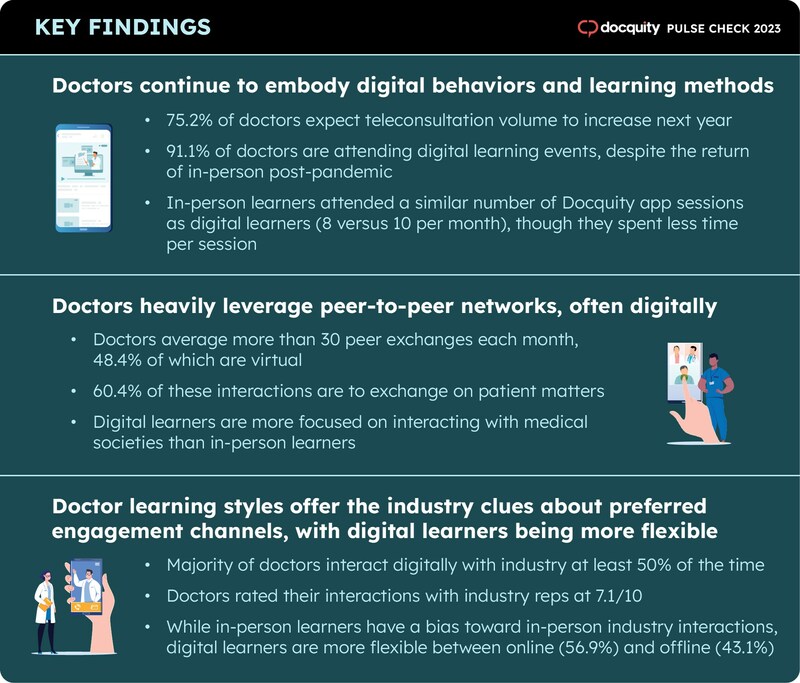- Docquity survey shows that doctor attendance at digital learning events is higher than in-person events (at 3.9 versus 3.0 times per month)
- While two learning cohorts have emerged – digital dominant learners and in-person dominant learners, both groups participate in digital learning yet display unique engagement behaviors
Despite a societal return to in-person interactions, 91.1% of Southeast Asia’s doctors continue to participate in digital learning events, according to the newly published Docquity Pulse Check 2023: Decoding a Doctor’s Learning and Engagement Habits. The study showed that the region’s doctors attend digital learning events at a higher rate (3.9 times per month) compared to in-person events (3.0 times per month).
As Southeast Asia’s largest digital network of more than 400,000 doctors, connecting two out of every three in the region, Docquity has gained insights into doctors’ practice and learning preferences, peer-to-peer interactions, and engagements with pharmaceutical and medical device companies.
Based on a survey that ran from March to May 2023 among over 2,500 general and specialty doctors across Southeast Asia, the study found that two distinct learning cohorts of doctors have emerged — digital dominant learners and in-person dominant learners. However, neither cohort has exclusively online or offline preferences, as in-person learners attend a similar number of Docquity app sessions as their digital counterparts, but spend less time per session, while digital learners are more flexible across different industry engagement channels.
“Digital solutions continue to be a compelling way for doctors to overcome legacy health system constraints in Southeast Asia, including access and resource barriers,” Indranil Roychowdhury, Docquity CEO and Co-Founder, said. “Our 2023 survey has shown that rather than thinking about doctor learning and engagement styles as either all digital or all in-person, the healthcare industry needs to embrace a meaningful blend of both formats and an impactful use of digital to effectively reach both learning cohorts.”
Digital practices, learning, and collaboration ease healthcare challenges
With the doctor-patient ratio in Asia remaining below the OECD average[1], 75.2% of Southeast Asia’s doctors anticipate the continued rise of teleconsultations in the coming year.
Docquity found that the growth of digital healthcare is in line with doctor learning habits too. For example, when given the choice within hybrid learning contexts, majority of the region’s doctors (65.9%) opt to participate digitally. As doctors contend with overwhelmed schedules, more than half (52.9%) gravitate towards digital learning due to the convenience of on-demand content.
Digital peer-to-peer networks are also crucial in alleviating the stress of strained healthcare workforces. Docquity found that doctors in the region interact with other doctors daily or more, with 48.4% of these connections happening virtually. While discussing patient matters is the primary driver (60.4%) for peer-to-peer interaction, social support (20.4%) is also high on the list.
Effective industry outreach must blend digital and in-person
The Docquity study noted that learning styles offer the healthcare industry clues about a doctor’s preferred industry engagement channels. Just as both learning cohorts’ similar number of Docquity app sessions demonstrate how preferences are not mutually exclusive, doctors’ industry engagements also exhibit notable nuances. While in-person learners display an 80.6% bias toward in-person interactions with industry reps, digital learners indicate greater flexibility between online (56.9%) and offline (43.1%) engagements.
Doctors view these engagements across channels as generally beneficial, rating them at 7.1 out of 10, with the majority saying they interact with industry reps via digital channels at least 50% of the time.
“The survey results have shown that healthcare has been irreversibly digitalized,” Roychowdhury added. “The substantial market share of digital and nuanced doctor preferences highlight a strong opportunity for industry companies to improve the quality of doctor interactions by maximizing online outreach, to complement a strategic allocation of offline engagements.”
Here’s a snapshot of key findings from Docquity Pulse Check 2023:
Photo – https://mma.prnewswire.com/media/2208238/Docquity_Pulse_Check_PR_Image.jpg
For a more detailed description of survey insights around the major themes of doctor learning habits, peer-to-peer interactions, and opportunities for industry engagement, get the full report here. Country chapters are provided in the Appendix.
About Docquity, https://docquity.com/
Docquity is Southeast Asia’s largest trusted community of verified healthcare professionals. Our vision is to connect healthcare professionals to build healthier lives around the world at scale. Docquity helps healthcare professionals learn, connect and grow, and partners with companies to reach and educate healthcare professionals as well as provide insights into them.
Docquity has more than 400,000 HCPs on the platform and offices in India, Indonesia, the Philippines, Malaysia, Singapore, Thailand, Vietnam, and Taiwan.
[1] OECD. (2022). Health at a Glance Asia/Pacific 2022. OECD iLibrary
